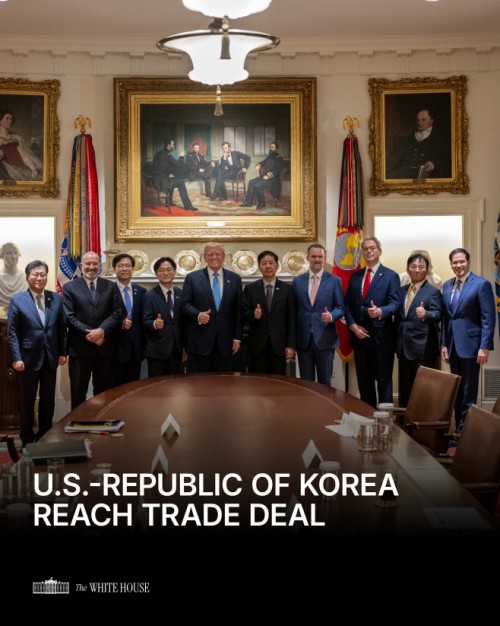 |
| U.S. President Donald Trump (fifth from left) meets South Korea’s trade delegation, including Deputy Prime Minister Koo Yun-chul (sixth from left), during tariff negotiations at the White House on July 30. / Source: White House via X |
U.S. Trade Representative (USTR) Jamieson Greer said on August 3 that reciprocal tariff rates, set to take effect on August 7, are "virtually finalized," indicating that reductions through negotiations are unlikely.
In an interview with CBS, Greer explained that President Donald Trump determines tariff levels "by considering each country's concessions, desired rates, and the impact on reducing the U.S. trade deficit." He added, "These tariffs are largely fixed based on trade balances, with some agreements already announced and others still pending."
When asked if certain countries had no choice but to accept tariffs, Greer said Trump "reviews potential concessions from each nation, compares them against possible tariffs to reduce deficits, consults advisors, and then decides," sometimes prompting countries to offer further concessions.
Greer emphasized that the ultimate goal is addressing the "net result" of past trade agreements—significant manufacturing outflows—which he argued rendered "the current system unsustainable."
Trump has already imposed reciprocal tariffs of 15% on South Korea, 35% on Canada, and 25% on Mexico, despite signing updated trade deals such as the revised Korea-U.S. FTA in 2018 and the USMCA in 2020. He also levied a 50% tariff on Brazil, citing the International Emergency Economic Powers Act (IEEPA) to justify the measure for "geopolitical reasons."
According to The New York Times, U.S. tariff revenues nearly doubled year-over-year, reaching $152 billion from January to July, up from $78 billion in the same period last year. The paper cited Treasury data, projecting that if tariffs remain, they could generate over $2 trillion in revenue over the next decade.
While many economists warn tariffs burden the economy—raising consumer prices and disproportionately affecting low-income households—NYT noted that even a future Democratic administration might struggle to abandon such a "highly addictive" revenue source.
Wharton School professor Joao Gomes said, "This is addictive. In today’s debt and deficit environment, it's very hard to walk away from such revenue." Ernie Tedeschi of Yale’s Budget Lab added that both Republican and Democratic leaders may hesitate to remove tariffs if doing so exacerbates federal debt pressures.
NYT suggested that maintaining tariffs may become the politically easier path, especially since replacing them with alternative taxes would require congressional approval.
Trump has floated the idea of rebating some tariff revenues directly to Americans, while Sen. Josh Hawley (R-MO) has proposed legislation granting every citizen at least $600 from tariff proceeds.
Most Read
-
1
-
2
-
3
-
4
-
5
-
6
-
7





















